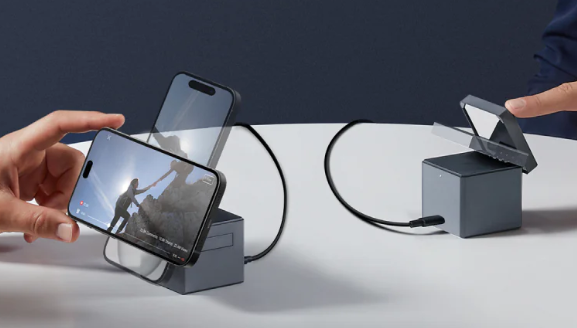Wireless charging has become increasingly popular due to its convenience and the elimination of tangled cables. However, many users are concerned about the safety of this technology for their phones. Understanding the potential risks and benefits associated with wireless chargers can help you make an informed decision about using them. This article will explore the common concerns about wireless charging, how to use these chargers safely, the long-term effects on your device, and the overall benefits of adopting this technology.
What Are the Potential Risks of Wireless Charging?
Can Wireless Charging Damage Your Battery?
One of the main concerns about wireless chargers is whether they can damage your phone’s battery. Over time, any charging method can cause wear on a battery, but there is no conclusive evidence that wireless charging causes more damage than wired charging. The heat generated during wireless charging is similar to that produced by conventional chargers. To minimize any potential damage, it is essential to use a high-quality [wireless charger] and avoid exposing your phone to extreme temperatures during the charging process.
Do Wireless Chargers Emit Harmful Radiation?
Another common concern is the radiation emitted by wireless chargers. These chargers use electromagnetic fields to transfer energy, which can raise questions about safety. However, the levels of radiation emitted are significantly lower than those from everyday devices like Wi-Fi routers and cell phones. Regulatory bodies, such as the FCC, ensure that wireless chargers meet strict safety standards, so the risk of harmful radiation is minimal. Using certified wireless chargers further ensures that you are not exposed to unsafe levels of radiation.
Are Wireless Chargers Prone to Overheating?
Overheating is a potential risk when using any charging method. Wireless chargers can sometimes generate more heat than wired chargers, especially if they are not properly aligned with the device. This heat can be harmful to both the charger and the phone. To prevent overheating, use a reputable [wireless charger] and ensure your device is correctly positioned on the charging pad. Additionally, avoid covering the charger with objects or placing it on soft surfaces that can trap heat.
How to Ensure Safe Wireless Charging
Choosing the Right Wireless Charger
Selecting a high-quality wireless charger is crucial for safe and efficient charging. Look for chargers that are Qi-certified, as this certification ensures that the product meets industry standards for safety and performance. Reputable brands like Anker offer reliable [wireless chargers] that are designed to protect your phone from potential risks. Additionally, check user reviews and ratings to ensure that the charger you choose has a good track record of safety and reliability.
Proper Placement and Usage
Proper placement of your phone on the wireless charger is essential for safe charging. Ensure that the device is aligned with the charger’s coils to maximize efficiency and reduce the risk of overheating. Avoid placing metal objects between your phone and the charger, as they can interfere with the charging process and cause heat build-up. Following the manufacturer’s guidelines for placement and usage can help you avoid common issues and ensure that your phone charges safely.
Monitoring Charging Temperatures
Keeping an eye on the temperature of your phone and charger during the charging process can help prevent overheating. If you notice that either becomes excessively hot, it may be a sign of a problem. Disconnect the charger and allow both devices to cool down before attempting to charge again. Regularly cleaning your wireless charger and ensuring it is free of dust and debris can also help maintain optimal performance and prevent overheating issues.
Are Wireless Chargers Safe for Long-Term Use?
Long-Term Effects on Battery Health
The long-term effects of wireless charging on battery health are a topic of ongoing research. While some studies suggest that wireless charging may lead to slightly faster battery degradation compared to wired charging, the difference is generally minimal. Using a high-quality [wireless charger] and following best practices for charging can help mitigate any potential long-term effects. Avoiding extreme temperatures and keeping your phone’s software updated can also contribute to maintaining battery health.
Wear and Tear on Wireless Chargers
Like any electronic device, wireless chargers can experience wear and tear over time. Regular use can lead to issues such as reduced charging efficiency or physical damage to the charging pad. To prolong the lifespan of your wireless charger, handle it with care and avoid placing heavy objects on it. Additionally, unplug the charger when not in use to prevent unnecessary wear. Investing in a durable, high-quality charger can also reduce the likelihood of experiencing wear and tear issues.
Comparing Wireless and Wired Charging
When comparing wireless and wired charging, both methods have their pros and cons. Wireless charging offers convenience and reduces cable clutter, but may be slightly less efficient than wired charging. Wired charging is generally faster and may be more reliable in some cases. However, both methods are safe when using high-quality chargers and following best practices. Ultimately, the choice between wireless and wired charging depends on your personal preferences and how you prioritize convenience and charging speed.
What Are the Benefits of Wireless Charging?
Convenience and Ease of Use
One of the primary benefits of wireless charging is the convenience it offers. Simply placing your phone on a charging pad eliminates the need for cables and makes it easy to charge your device. This ease of use can be especially beneficial in situations where you frequently need to pick up and use your phone. Wireless charging pads can be placed in various locations around your home or office, providing a seamless charging experience.
Reducing Cable Clutter
Wireless charging helps reduce cable clutter, which can be a significant advantage in maintaining an organized space. With fewer cables to manage, your desk or nightstand can look cleaner and more streamlined. This reduction in clutter can also make it easier to keep track of your charging accessories and prevent the frustration of tangled cords. By using a [wireless charger], you can simplify your charging setup and create a more aesthetically pleasing environment.
Enhanced Device Compatibility
Many modern devices are compatible with wireless charging, making it a versatile solution for charging multiple gadgets. From smartphones to wireless earbuds, a single wireless charger can often charge various devices. This compatibility can be especially useful for households or offices with multiple devices that need charging. Investing in a high-quality wireless charger can provide a convenient and efficient charging solution for all your compatible gadgets.
Conclusion
In conclusion, wireless chargers are generally safe for your phone when used correctly. While there are potential risks such as battery damage, radiation, and overheating, these can be minimized by using high-quality chargers and following best practices. The benefits of wireless charging, including convenience, reduced cable clutter, and enhanced compatibility, make it an attractive option for many users. By choosing a reputable [wireless charger] and ensuring proper usage, you can enjoy the advantages of this technology while keeping your phone safe.



